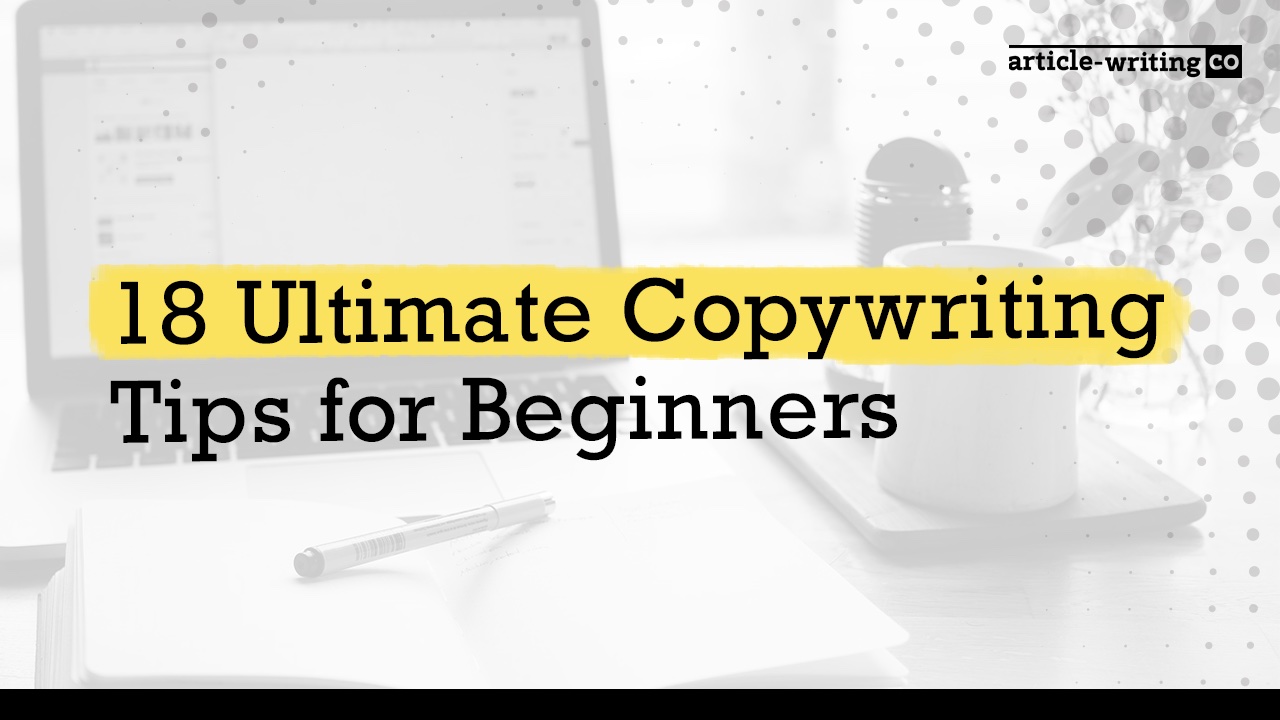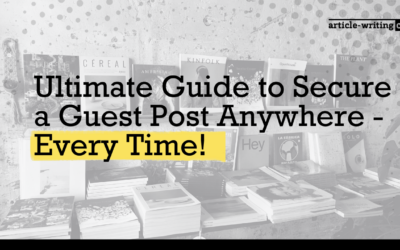Copywriting is not a piece of cake. Good copy must walk a fine line between encouraging consumer action without sounding too pushy. No matter where your copy is, it must be punchy and catch someone’s attention. It’s no secret that the skill will take some time to acquire properly. We’ve spoken with some professionals about the ideal copywriting tips beginners can learn.
1. Keep Writing
When you start out, the most important thing is to keep writing. If you don’t have to pay for client work, use that time to send cold emails with ideas to people you’d like to write for, write articles on Medium, answer Quora questions, join Reddit groups, and start blogging.

The more you write, the better you get. Plus, the stronger your portfolio, the more clients will trust you and hire you. And, when you can’t possibly write anything else, read and study what other copywriters are doing.
Erica Jabali, Copywriter and Blogger, ISpyFabulous.com
2. Focus on Benefits, Not Features
Start with your ideal customer. When you’re writing copy, you should know exactly who it is you’re talking to. Some people even create an avatar, which is the exact person they’re trying to market to.
For example, if you’re selling a fitness product, don’t just stop there. Ask yourself, “Who is my ideal customer? What is their body type? What’s their age?” The more specific you can get, the better. Think of their age, their height, their gender, what they do for work, and more.
Secondly, focus on the benefits, not the features. One of the biggest mistakes I see newbie copywriters make is emphasizing their products’ features but not the benefits.
Features are things that make the product different than others. For example, a car might have a deluxe package with numerous features, such as better air conditioning, leather seats, and a better steering wheel.
Instead of focusing on the features, however, emphasize the benefits. Tell your client about how the deluxe package will help keep them cool on hot summer days, or how it will provide them with a more comfortable driving experience.
Lastly, hit the key pain points. When you’re writing copy, it pays to know exactly what your clients’ biggest problems are. And no, I don’t just mean their general problems, like they want to lose weight or make money. You want to grind this down to be as specific as possible.
When it comes to writing copy, emphasizing on the pain points over and over again is where the money’s at.
Jon Anthony, Masculine Development
3. Maintain Conversational Copy
One of the common copywriting mistakes brands make is writing in a way that’s too formal and robotic—it doesn’t feel natural! What makes copywriting a different form of writing is that it’s meant to compel your target audience to connect with your message and take action emotionally.

A way to quickly transform bland content into great copywriting is to relay your message, in the same manner, you would when speaking to a friend. This means explaining things in simple ways while being descriptive. It also means using contractions to mimic a conversational tone.
Instead of saying, “As a result of working with me, you will gain clarity and examine how to get past the emotional hurdles that are pulling you down,” try this instead: “Together we’ll look at what’s making you feel heavy and create an easy plan that’ll get to the heart of your concerns so that you feel good again.”
Ditch the jargon and formal writing (sometimes even forgoing traditional grammar rules!) and write for impact. If you speak in your audience’s language, they’ll hear your message—and act!
Marietta Gentles Crawford, Founder, MGC Ink
4. Use Hemingway’s Help
Use the Hemingway App. It’s the best $20 I have spent on my business. The app lets you know when your sentences get long or when you’re using complex language. It won’t help you write a classic American novel, but it’s great for creating punchy copy that converts.
Outline your copy first. Then, write section headers. Then, fill out your content. An excellent online copy can be skimmed. With this writing process, your content will read well to someone scrolling. Busy people will get the gist of your message and convert.
Paul Bromen, CEO, HelpfulHabitat
5. Tell Stories Whenever Possible
Write in the active voice. This is encouraged for every bit of writing, from emails to copy to articles and novels. It can be a hard habit to break, but copy in the active voice crushes passive voice copy.
Tell a story wherever possible, but keep your stories straight. Don’t get carried away. Your copy is always written to accomplish (that’s what makes it copy, not a different form of writing).
Benefits make sales, and features make failures. Features are aspects of a product or service that differentiate it from others. Benefits are how those points of differentiation translate into value for your target audience. Expressing a product or service in terms of what it can do to provide value to your readers (benefits) is much more effective than listing features.
Benjamin Sweeney, ClydeBank Media
6. Do Competitor Research
Do extensive competitor research when writing a new article, blog post, or copy for a webpage. One of the easiest ways to do this research is to take the target keyword you plan to write on, google it, and read through the posts or pages of the sites that rank for that keyword.

They’ll offer you direction on what readers value and what Google thinks is the top resource for that keyword. For example, if you’re writing an article on copywriting tips, google ‘copywriting tips’ and review the top results for:
- how long the article is by word count
- what additional resources are included in the article like graphs or examples
- what types of tips are offered
- how the page is formatted
You certainly shouldn’t copy the top posts, but you should aim to make your piece more informative than top competitor posts. Combining elements from the top posts in particular, will be helpful. Also, pay attention to the titles and meta descriptions of top posts. They’re clues to what you should address in your title and meta description.
For example, should you include ranking language like “27 Top Copywriting Tips” or include (Examples for Success) at the end of the article?
Nicolas Straut, Writer, Fundera
7. Master Subject Matter
Become a subject matter expert. This is challenging when you’re a beginner because you must take any client who will come to you. Ultimately, work toward focusing your efforts in one industry, such as healthcare, technology, retail, or finance. You’ll be more valuable to potential clients when you don’t need to learn how to write convincing copy that sells.
Become an expert storyteller, too. Whether you’re writing a blog post or an ad, stories sell. Learn how to interview people and write a compelling narrative. It serves as a convincing lede in long-form content, such as blog posts, and engages your audience quickly in ads, email copy, and social media posts.
Pamela Ellgen, Senior Marketing Copywriter, Health Editor, WELL Health Inc
8. Know Your Value
Keep it simple. As Shakespeare said, brevity is the soul of wit. To me, effective communication should be brief and concise. Good copy is written using language that’s clear, easy to understand, succinct and simple.
Also, draft an effective headline. Good copy lures the reader in by building off of the previous line of copy and compelling them to read the next line. And more often than not, a well-crafted headline will determine whether your reader even moves into the body copy.
Convey key messaging, too. Well-crafted copy brings your company’s tone, values and aspirations and any other company messaging together into a coherent whole.
A few other copywriting tips are:
- consider your audience
- use active voice
- be personal
- appeal to emotion
- know your value — and demonstrate it
In the end, the copy you produce shouldn’t leave any questions about the value of your product or service unanswered. Your audience wants to know why they should take action, and oftentimes your copy has to tell them why your offer stands out.
Drew Albee, Copy Specialist, MAPRagency
9. Develop an Editing Process
It’s essential to develop an editing process. If you don’t edit your content, you’ll find that your posts contain fluff that distracts from your core message.
After completing the first draft, I sift through the entire article and try to shorten sentences, remove sections that don’t add to my core message and add more sensory words where possible.
Once that process is completed, I use Grammarly to clean up any last grammar/wording edits.
Finally, I’ll follow my first draft editing process one more time, as there’s always something I miss. Having a systematic process improves my posts significantly!
Secondly, simplify as much as possible. You don’t have their full attention when someone is on the internet.

Therefore, it’s extremely important to use simple language that they can easily digest. Even though your readers are smart, most won’t want to expend mental energy trying to read through complicated concepts. They’ll simply decide to click the back button, and you might never see them again.
Axel DeAngelis, Founder, NameBounce
10. Devote Time to Your Headline
Spend 80% of your time writing your title and only 20% on the text. Spend the majority of your time writing your titles! A very important copywriting tip indeed! Whether it’s a blog post, webpage, landing page, or email (this would be the subject line) most people will read your title and decide if they want to continue reading based on that alone. Titles should be as impactful as possible.
Next, make your text scannable. It’s difficult to read long blocks of text. Optimize your text for maximum readability by making it easy to read as possible. This includes incorporating things like:
- headlines and subtitles
- bullet points
- numbered lists
- images with captions
- YouTube videos
- charts
- CTAs (i.e. Sign up Now, Read Now, Learn More, etc.)
- switching the cadence of your text (making sure you don’t just write in short or long sentences
Vanessa Perplies, Brand Storyteller, Workiz
11. Write Content, Not Copy
The difference between copywriting and content writing comes down to voice. Copywriting presents the brand as a product; content writing presents the brand as a person.
Why does this matter? Brands have sales quotas; people have values. Brands have ads; people have feelings and opinions.
The job role of a copywriter and content writer may appear the same at first glance: write words on behalf of a brand. However, the difference lies in the intent of the words.
A copywriter seeks to create value for the brand; a content writer seeks to create value for the consumer (thus adding value to the brand). Copy is for the shareholders, and content is for the consumer.
Today’s consumer is savvier than ever before, meaning they’re likely to be more sensitive to advertising. One of the biggest mistakes a brand can make is to cause consumers to feel advertised.
Consumers look to brands to add value, and the most effective content puts the consumer value upfront, with the brand value as secondary. Our approach to writing meaningful content begins with the personification of the brand. If your brand were a person, what would they say, and – more importantly – how would they say it? By writing for your consumer and not your shareholders, you create genuine content, not just copy.
Rachel Ford, President, Co-Founder, Ford Media Lab
12. Develop a Brand Voice
Practice and develop your brand voice. Find ways to define the voice of each brand you write for; put a face to the customer and think of that person as you’re writing.
Consistently ask yourself if you’re still speaking directly to them. This may feel like an awkward practice, but the more you do it, the stronger your copywriting skills will be!
Laurelei Litke, Digital Marketer, HealthLabs
13. Don’t Skimp on Good Copy
To succeed in today’s ever-growing world of content writing, you must be diligent in consistently creating good copy. Someone will remember that bad piece of copy you wrote, and saving a little time isn’t worth the bad press.
Remember, 5.8 million blogs are shared every day. So, the main thing to remember is that your content has to stand out. No matter how great your initial idea is, it won’t retain the reader’s interest if the content isn’t informative and high quality. Include important links early on, and break up the post with vibrant images and bullet points.
Angela Ash, Content Manager, Flow SEO
14. Build Relationships
Another great copywriting tip is to start building connections straight out of the gate. When you begin to contribute to a specific blog or site, be sure to connect with anyone else doing the same.
A newly-found colleague may share another site that beads copywriters; before long you’ll have several clients and a sustainable copywriting business.
Alexandra Zamolo, Head of Content Marketing, Beekeeper
15. Establish a Voice and Proofread
Think about your brand voice and keep it universal. Hubspot’s brand voice guide is a must-read to understand why it’s important for your copy to convey the values and style that customers will associate with your company. Do you want to sound approachable or sassy? You can’t be both. Brand voice helps tone and style stay unified.

Proofread. Spellcheck helps catch a lot of basic errors, but on its own it can still miss problematic grammatical and spelling mistakes. The Grammarly plugin is a must for catching mistakes when they happen. If you have the budget, it’s worth paying someone to edit your copy quickly.
Walls of text are horrible, but so are single-sentence paragraphs. The structure and layout of your copy are important because it helps guide your readers through it. It’s necessary to strike a balance between super-long paragraphs and super-short ones. Generally, three to five sentences are fine.
When in doubt, hire a professional. As a small business owner, time is your greatest asset, so if you can use it to grow your business by focusing on something other than copywriting, don’t be afraid to do that.
P.S. If you need a copywriter, our team can help you write any text from a blog post to a press release to a Guest Posting Campaign. These copywriting tips are just the tip of the iceberg.
Jake Rheude, VP of Marketing, Red Stag Fulfillment
16. Recruit a Mentor
Find a tribe and mentor. These will fast-track your progress big time. Doing it on your own is okay, but it takes time, self-discipline, and risk. You could get scammed, ripped off, underpaid, or waste time on the wrong technique or style.
So, you need guidance from more experienced copywriters. Peers and mentors can also critique your work, which helps you improve much faster than when you have no one checking on you.
Take advantage of all the free materials. There is plenty to keep you busy as a beginner.
Hazel Pan, Copywriter, Content Brewery
17. Read it Aloud
One of the best copywriting tips is to read the copy out loud! This is a quick way to actually feel the copy and, get a sense of voice, any awkwardness, and improve the feel on the fly. People often don’t write how they speak, which can result in a confusing or overly wordy message.
Reading the copy out loud will help you better determine if it needs to be tightened and whether things need to be clarified. You can even read the copy to coworkers and seek their input.
Reading what you wrote aloud is also beneficial because it helps prevent you from missing sloppy mistakes that you might not catch if you’re only looking at the words on a computer screen.
We all know it doesn’t take long for your eyes to get tired after staring at a screen. So, taking a break to read your copy out loud can help you focus more on the task at hand and make you are copywriting that much better!
Liz Jeneault, VP of Marketing, Faveable
18. Don’t Beat Around the Bush
Use facts. The easiest thing to do in copywriting is to exaggerate whatever you’re trying to sell. For example, you may say that hundreds of thousands of people bought the product last year.
Instead, use the exact statistic. “125,387 people bought our phone case in 2023.” This sounds better and shows that you aren’t making things up to show that the product is more successful than it is.
Be direct. The worst practice in copy is being indirect and suggestive. When urging a customer and trying to gain more sales for a product, never say things like “You should try” or “If you’d like to join.” These phrases are pointless and lead to a dull experience. Instead, tell the consumer exactly what you want them to do. “Sign up now” or “Click here to buy” will receive many more clicks, views, and purchases.
Ethan Lichtenberg, AutoInsuranceEZ.com
Turning Copywriting Tips into Conversions
Are you looking to give your business messaging a breath of fresh air? Take the plunge and order copywriting services from AWC. With our skilled team, you’ll be able to communicate with potential customers on a level that resonates. Plus, sharpened prose and engaging content is sure to make your website stand out from the competition.
So don’t wait – take advantage of our copywriting tips, get in touch, and watch your audience grow! We’d love to help you make an impression in the marketplace, so let us show you what we can do.
Step up your copywriting game today and contact AWC for all of your needs! You’ll be surprised at how quickly we can become indispensable allies in your journey to success. What are you waiting for? Get started now and enjoy positive results tomorrow! It’s time to see why everyone’s raving about AWC – order your services today!

David is the Founder and Director of article-writing.co, the fastest-growing content creation agency in North America. He has transformed companies by offering high-quality content that has impacted their SEO ranking, revitalized websites with engaging and industry-relevant blogs and website copy, and championed successful email campaign copy.




